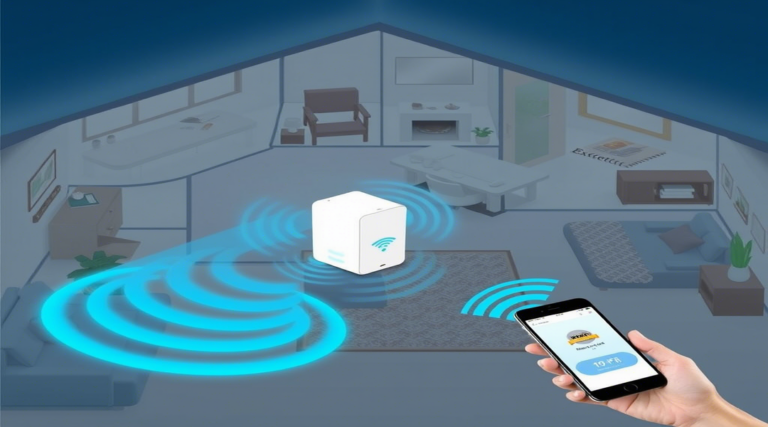WiFi Security: 7 Easy Ways to Protect Your Network
Did you know that an unsecured WiFi network is like leaving your front door wide open for hackers? [WiFi Security] is more important than ever, yet many people overlook simple steps that can protect their personal data. Cybercriminals can exploit weak WiFi security to steal sensitive information, install malware, or hijack your bandwidth.
According to recent reports, over 40% of home networks have weak security settings, making them easy targets for hackers. While you might think that your home WiFi is safe, an outdated router or a weak password can expose you to cyber threats.
Protecting your WiFi isn’t just about keeping hackers out—it’s also about ensuring your internet speed remains fast and reliable. A secure network prevents unauthorized users from slowing down your connection, keeps your data private, and safeguards your devices from malware attacks.
In this guide, we’ll explore the best practices for WiFi security, breaking down seven easy ways to protect your network. Let’s dive in and lock down your WiFi like a pro!
Table of Contents
What is WiFi Security?
[WiFi Security] refers to the measures taken to protect wireless networks from unauthorized access, cyber threats, and data breaches. Ever wonder how hackers manage to access unsecured WiFi? They use simple hacking tools to crack weak passwords, intercept data, or even take control of your router remotely.
Think of your WiFi like a digital fortress. Without proper defenses, anyone nearby can sneak in, steal your data, and use your internet without you even knowing! The good news? Strengthening your WiFi security is easier than you think. Let’s explore why it matters and how you can secure your network effectively.
Why You Should Secure Your WiFi Network
1. Prevent Unauthorized Access and Bandwidth Theft
An unsecured WiFi network allows strangers to use your internet, slowing down your speed and exposing you to security risks. Hackers can exploit your network to conduct illegal activities, leaving you liable.
2. Protect Personal and Financial Information
Cybercriminals can intercept sensitive data, including passwords, banking details, and personal messages. A weak WiFi security setup puts your online privacy at risk.
3. Improve Network Performance
Too many unauthorized devices can clog your bandwidth, leading to slow internet speeds. Securing your WiFi ensures that only trusted devices have access, keeping your connection fast and efficient.
How to Secure Your WiFi Network
Quick Overview
Securing your WiFi is easier than you think! Key steps include using strong passwords, enabling encryption, updating firmware, and setting up firewalls. Let’s break it down step by step.
Key Steps to Strengthen WiFi Security
- Change the Default Router Password – Default passwords are easy to guess. Set a strong, unique password for your router.
- Enable WPA3 or WPA2 Encryption – Encryption scrambles data, making it unreadable to hackers.
- Disable Remote Access and WPS – Remote access features can be exploited by attackers.
- Hide Your SSID (If Necessary) – Prevent casual snoopers from discovering your network.
- Set Up a Guest Network – Keep visitors on a separate, restricted network.
- Update Router Firmware Regularly – Security updates patch vulnerabilities.
Step-by-Step Guide to Securing Your WiFi
- Log into your router’s admin panel (usually via
192.168.1.1). - Change the default username and password.
- Enable WPA3 or WPA2 encryption under security settings.
- Turn off remote management and WPS.
- Update your router firmware.
- Set up a guest network with a separate password.
- Regularly monitor connected devices to detect any unknown users.
Common WiFi Security Threats and How to Avoid Them
- Man-in-the-Middle (MITM) Attacks – Use strong encryption and a VPN.
- WiFi Eavesdropping – Disable WPS and use WPA3.
- Router Malware – Update firmware and install security patches.
- Weak Password Vulnerabilities – Use a long, complex password with symbols and numbers.
WiFi Security vs. Public Networks
Public WiFi is convenient but highly insecure. Hackers can easily intercept unencrypted traffic, putting your data at risk. To stay safe:
- Avoid accessing sensitive accounts on public WiFi.
- Use a VPN for encrypted browsing.
- Turn off automatic WiFi connections.
Advanced Tips for Ultimate WiFi Security
- MAC Address Filtering – Only allow specific devices to connect.
- Firewalls – Use built-in router firewalls and security appliances like the FortiGate 40F WiFi.
- Two-Factor Authentication (2FA) – Protect router admin access.
- Monitor Connected Devices – Use a WiFi security app to track unauthorized users.
Final Thoughts: Is Your WiFi Secure?
WiFi security is a must in today’s digital age. A well-protected network safeguards your personal data, enhances internet performance, and prevents cyber threats. Here’s a quick checklist: ✔ Strong, unique WiFi password ✔ WPA3/WPA2 encryption enabled ✔ Firmware updated ✔ Guest network for visitors ✔ Remote access disabled
Take action now and secure your WiFi today!
FAQ: WiFi Security Essentials
1. What are the best WiFi security protocols?
WPA3 and WPA2 are the most secure protocols for home networks.
2. How does the SonicWave 224w enhance WiFi security?
The SonicWave 224w provides advanced encryption, intrusion detection, and secure remote management.
3. Is the FortiGate 40F WiFi a good security appliance?
Yes, it offers robust firewall protection, VPN support, and network monitoring.
4. What is the safest WiFi security type?
WPA3 is currently the safest, offering strong encryption and protection against brute-force attacks.
5. Do I need a WiFi security app?
Yes, apps like Netgear Armor or Bitdefender help monitor and protect your network.
6. How can a Sophos Wireless Access Point improve security?
Sophos APs offer enterprise-grade security, intrusion prevention, and seamless encryption.
7. What’s the difference between WiFi 7 routers and older models?
WiFi 7 routers provide faster speeds, lower latency, and improved security features.
8. Is the V380 Pro WiFi Security Camera safe to use?
Yes, if configured correctly with strong passwords and regular firmware updates.
9. How do security appliances protect my wireless network?
They provide firewall protection, intrusion detection, and traffic monitoring.
10. How can I make my WiFi network safe from hackers?
Use strong passwords, enable WPA3 encryption, update firmware, and monitor connected devices regularly.
Now that you know the essentials of [WiFi Security], take action to protect your home network today!







